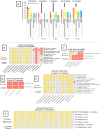Proteins, possibly human, found in World War II concentration camp artifact
- PMID: 35858951
- PMCID: PMC9300652
- DOI: 10.1038/s41598-022-16192-5
Proteins, possibly human, found in World War II concentration camp artifact
Abstract
Museums displaying artifacts of the human struggle against oppression are often caught in their own internal struggle between presenting factual and unbiased descriptions of their collections, or relying on testament of survivors. Often this quandary is resolved in favor of what can be verified, not what is remembered. However, with improving instrumentation, methods and informatic approaches, science can help uncover evidence able to reconcile memory and facts. Following World War II, thousands of small, cement-like disks with numbers impressed on one side were found at concentration camps throughout Europe. Survivors claimed these disks were made of human cremains; museums erred on the side of caution-without documentation of the claims, was it justifiable to present them as fact? The ability to detect species relevant biological material in these disks could help resolve this question. Proteomic mass spectrometry of five disks revealed all contained proteins, including collagens and hemoglobins, suggesting they were made, at least in part, of animal remains. A new protein/informatics approach to species identification showed that while human was not always identified as the top contributor, human was the most likely explanation for one disk. To our knowledge, this is the first demonstration of protein recovery from cremains. Data are available via ProteomeXchange with identifier PXD035267.
© 2022. The Author(s).
Conflict of interest statement
The authors declare no competing interests.
Figures



References
-
- Freedman, S. G. A resolution at last for a father’s unsettling legacy. The New York Times A11 (2014).
-
- Singer M. Growing up on the museum mile: introducing the heritage project of the Cape Town Holocaust Centre. S. Afr. Mus. Assoc. Bull. 2013;36:51–64.
-
- Buckley M, Collins MJ. Collagen survival and its use for species identification in Holocene-lower Pleistocene bone fragments from British archaeological and paleontological sites. Antiqua. 2011;1:1. doi: 10.4081/antiqua.2011.e1. - DOI
Publication types
MeSH terms
LinkOut - more resources
Full Text Sources
Molecular Biology Databases

